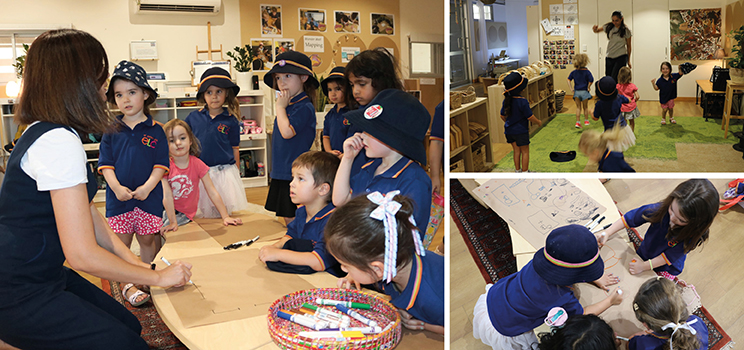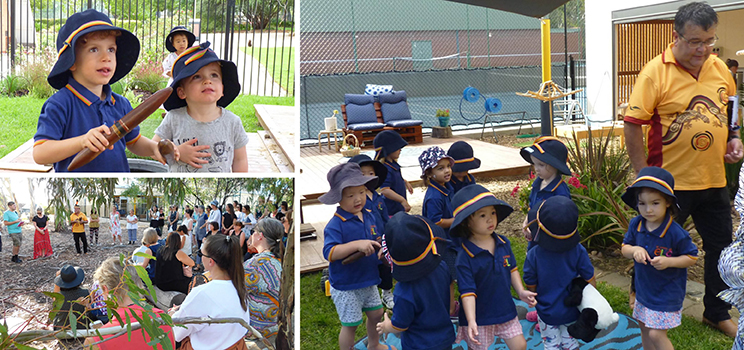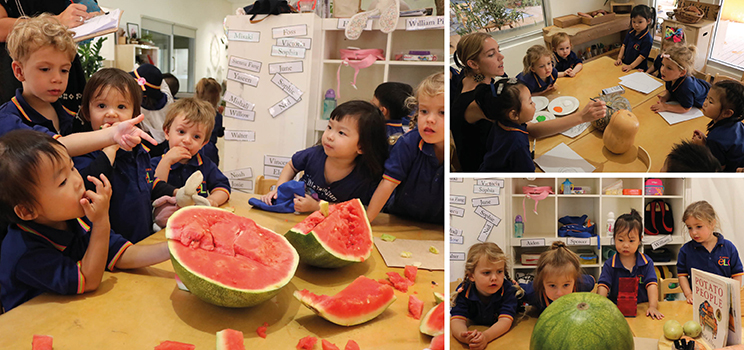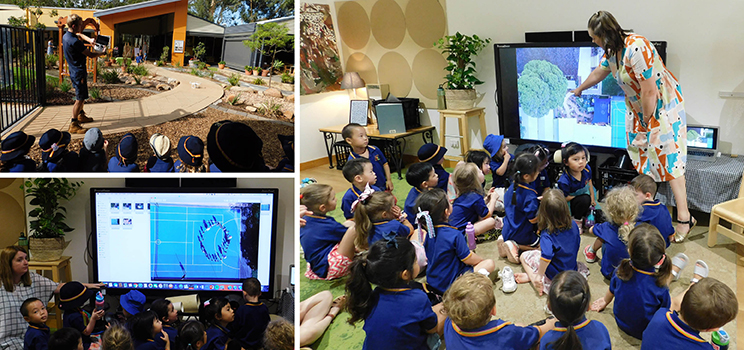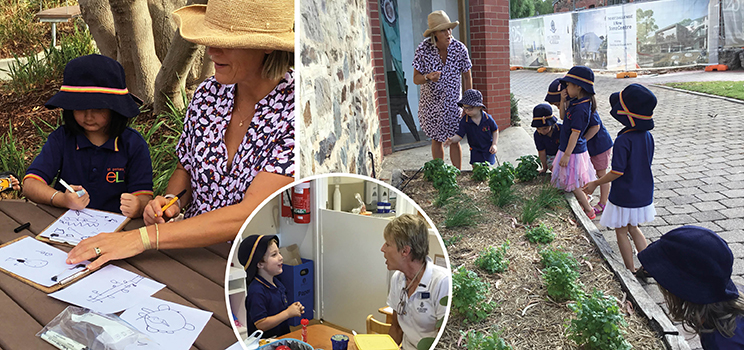From the Director of Early Learning
Dear Families

What a glorious evening that we shared together last Friday with our Term 1 Twilight Picnic. Thank you to everyone for coming along and sharing our picnic on the lawns. You can read more about this fantastic community event below.
This week’s edition from Learning Community 2 has a strong focus on digital technology in the ELC, we believe this is a very important area to build an understanding about. Please take time to read Kirsty Porplycia’s article below and to view the video that has been made to support this.
As we enter the final month of Term 1, I would like to draw your attention to a few important things:
- Vacation Care forms will be distributed this week. Please fill them out for the sessions you require during the two week period. For our new families please note that term time bookings do not apply during this period of Vacation Care. You may choose to attend the same sessions, or more or less depending on your situation. You will only be booked for what you require. Normal bookings commence at the beginning of Term 2. If you have not received a form, you can download one here.
- ELC photos are next Monday, Tuesday and Wednesday (March 25, 26 and 27). The photo forms have been sent home so please fill these out and return to us by the end of this week. We will organise for your child to have an individual and a group photo. Please speak to us if you have any queries regarding these.
- Portfolios and parent communication – The teachers are busy collating your child’s portfolio ready for you to share with your child at the ELC. These will then become something you can regularly refer to within the room for updates on the learning that is occurring at ELC. We will be inviting families in at the beginning of Term 2 for a Parent-Teacher Conversation about your child’s learning journey this year. If you have anything that needs more urgent discussion please organise a meeting time with your teacher.
Thank you again for your level of engagement with life at ELC and for your willingness to support us in so many ways. It is truly valued by all of the educators.
Kind regards
Kate Mount
Director of Early Learning
Save the Date
Monday 25 – Wednesday 27 March: ELC Photos
Thursday 11 April: Friends of the ELC Easter Morning Tea 8.30am
Monday 15 April: Vacation Care begins
Monday 29 April: Term 2 begins
Monday 13 – Wednesday 15 May: Parent-Teacher Conversations
Sunday 26 May: Ladies’ Day Out
Twilight Family Picnic
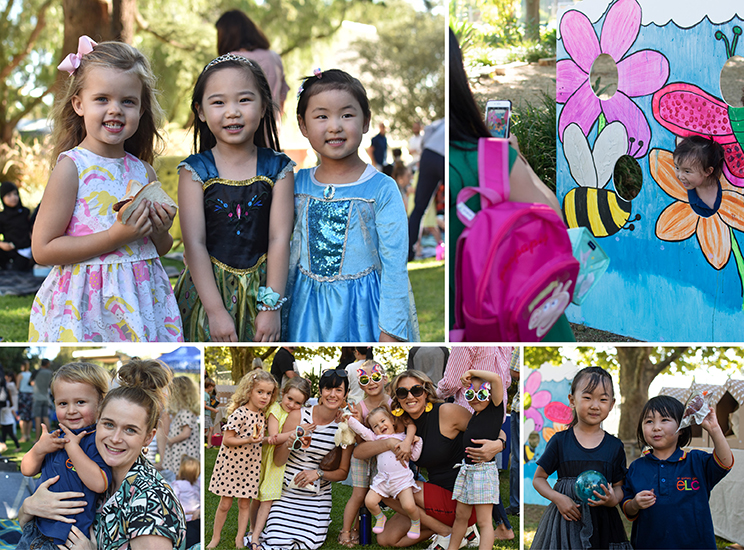
Friday night’s Twilight Family Picnic was a fantastic example of the strong sense of community we have built at the ELC. Together we celebrated the relationships that we have formed together as a community with a mixture of new and established families.
It was lovely to witness connections being made, picnic rugs being shared and my amazing team all present to spend time with you all. It is a truly magical feeling to know we have established such a warm and strong community at the ELC, certainly something the Friends of ELC and the ELC staff hold very high in our mission!
After all, the key purpose is to establish a trusting environment for our children to learn and develop in these important foundation years so thank you very much for partnering with us in this!
Kate Mount
Director of Early Learning
Living in a Digital World
In the ELC we use a range of digital technologies to enhance the children’s learning. These technologies engage children in a variety of experiences to develop their digital literacies and early coding skills. In Learning Community 2 we have placed a focus on the role and use of digital technologies with and by children in our setting. The need for this focus has derived from children increasingly growing up in digital contexts.
Digital technologies build on and extend ICT, moving from technology consumers to creators. Digital Technologies include computers, tablets, smart TVs, smart phones and smart watches. This term the ELC children in Learning Community 2 have been using applications on a smart phone to support their mapping, learning alongside Ada our NAO Humanoid Robot and exploring directional language/concepts using the Bee Bots.
The educators have been intentional in giving children the opportunity to use digital devices for exploration, collaboration and problem-solving. It is important that the children have the opportunity to explore and play with the technology that is on offer in the ELC so that they have the opportunity to become familiar with the different features and functions.
Children in digital contexts interact, engage, access and learn how to use digital technologies in relationships with others. In the ELC we place importance on using digital technologies to promote social interactions between children and adults. As the children learn alongside each other they are co learning about and with digital technologies. When the children are immersed in an experience and are teaching and sharing their knowledge with each other, their perspectives are enriched and they learn concepts better.
We pride ourselves in being a centre that is up to date with relevant and cutting edge teaching methodologies, therefore we wanted to ensure that we were using digital technologies in such a way that was further enhancing and developing the children’s research. This year, Miss Laura Reiters, Kate Mount and myself have the privilege of working alongside our school colleague, Mr Garth Coulter, Head of Tech and Digital Learning to reimagine technology and digital learning in the ELC. We are looking forward to the possibilities and opportunities that this partnership will provide.
Kirsty Porplycia
Sharing Stories with Boori Monty Pryor
Last week, the children had a visit from Boori Monty Pryor, an Indigenous Australian writer best known as a storyteller and as the inaugural Australian Children’s Laureate. This is his fourth visit to our ELC. During his visit Boori gifted us with several of his stories, some of which are over 30,000 years old. As he engaged the children with culture through storytelling, song, dance and music, he explained that his stories were now our stories and that together we could create a positive vision for the future for all Australians. Watch our special video to see more.
ELC Photos
This year, our ELC group and individual photos will be held on Monday 25 to Wednesday 27 March, from 9am – 12 noon.
Please ensure your child is wearing their ELC uniform on each of these days as they will potentially appear in multiple class shots, depending on the days they attend. Please also ensure your child’s hair is styled as neatly as possible.
You will be receiving a letter with more detailed information. If you have any questions or require further information, please contact me via kmount@stpetersgirls.sa.edu.au. As you can imagine, these photos will require a large amount of organisation and we appreciate your support and cooperation.
Kate Mount
Director of Early Learning
Accessing your Child’s Canvas Page
Your child’s Canvas homepage is a dynamic online sharing space that invites you to participate in your child’s learning as it happens. It provides a window into your child’s life at the ELC as educators share intentional teaching, specialist lessons and spontaneous moments.
We can share videos and images directly with parents that capture the rich learning experiences in which your child is engaged throughout their time at the ELC. The Canvas homepage also enables us to share more of the process of learning – rather than just the end product.
Your child’s Canvas page is accessed through the myLink Parent Portal. If you have not accessed your child’s Canvas page before, please follow the below instructions.
Accessing Canvas through the myLink Parent Portal:
To access myLink for the first time, please follow these simple steps:
- Visit https://mylink.stpetersgirls.sa.edu.au
- To set your first password, click the link below the sign in section
- Enter your username, click ‘Next’
- On the next screen, enter the security code emailed to you
- Enter the password you would like to use and press submit
- Return to the login screen at https://mylink.stpetersgirls.sa.edu.au to access myLink
- Several instructional videos are available via the Welcome page if you click on the “How to use myLink” tile.
If you have any problems accessing or navigating myLink, please contact the IT Helpdesk on 8334 2227 or email helpdesk@stpetersgirls.sa.edu.au.
Photo Etiquette:
Please note that your child’s Canvas homepage and Portfolio will contain some images and video footage of other children. We therefore ask that you do not copy or share images or videos, especially on social media, if they contain other children.
Signing in via iCheck-In
Last year, St Peter’s Girls’ Early Learners’ Centre introduced iCheck-In – new easy-to-use software that enables you to digitally sign in and out of our ELC, bringing us in line with updated Government regulations.
Please note, signing your child in/out daily using the iPad provided is a legal requirement. If you are having issues signing in/out, please ask an ELC educator to help you.
On your first login, you will be asked to enter your mobile phone number and a password will be sent via SMS which you will need to use every time you sign your child in or out of the ELC. Each family member will need to enter their own phone number and password when signing in/out, so please do not give your password to others.
Please refer to this instructional poster to familiarise yourself with the new procedure. This will also be on display next to the iPad when you sign your child in or out.
If you have any queries, please contact Sarah Elliott via 8334 2271 or selliott@stpetersgirls.sa.edu.au.
ELC Goes Egg-Free
We ask that you do not pack nuts or eggs or food containing these ingredients as we have children within our Centre who have severe allergies to them. We request that families be responsive to our requests when packing their child’s lunch box. We are also removing items containing eggs from the Tuck Shop menu.
We thank you kindly for assisting us to support all children and staff’s health and safety whilst in our care.
来自黄老师的信息
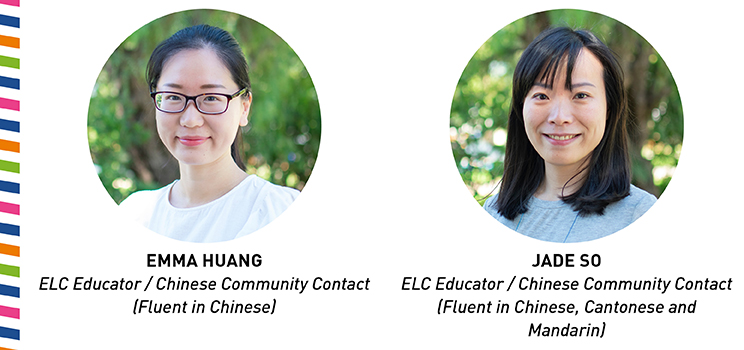
亲爱的家长朋友们,
在3月15日我们渡过了一个十分美妙的ELC暮光野餐会夜晚。在这里十分感谢所有参与的家庭,也感谢所有给予我们帮助和支持的家长朋友们。老师们都十分高兴能和大家有这样的愉快的互动。我们也很高兴我们能有这样一个紧密的社区。
接下来这一周我们会发出这个学期的假期日托班报名表格。请家长们及时填写并在当周交还给我们。如果您有任何的疑问可以咨询我们的教师们。希望家长们及时预订,因为假期日托班同平时学期内上课日期可以有所不同。
3月25日星期一到3月27日星期三是我们ELC的照片日。请家长们及时填写表格并及时交给我们老师。
Emma works in Learning Community 2 on Monday, Thursday, Friday from 9am – 5pm, and Jade works 11am – 6pm every day in Learning Community 1.
Ladies’ Day Out
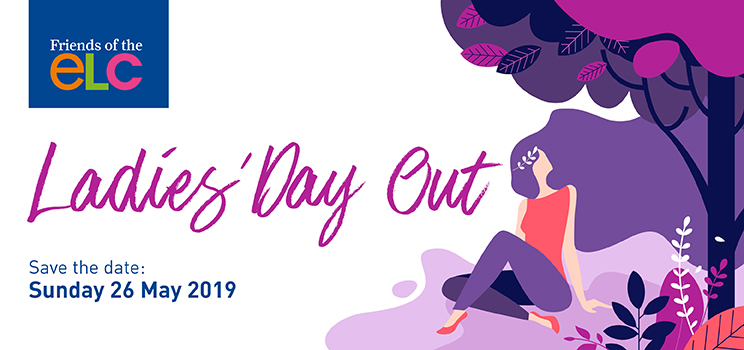
Save the date for the Friends of the ELC’s Ladies’ Day Out event on Sunday May 26, 2019. It will be a fantastic opportunity to spend the day with other ELC Mum’s in a beautiful winery setting.
Learning Community 1
News from the Stonyfell Room
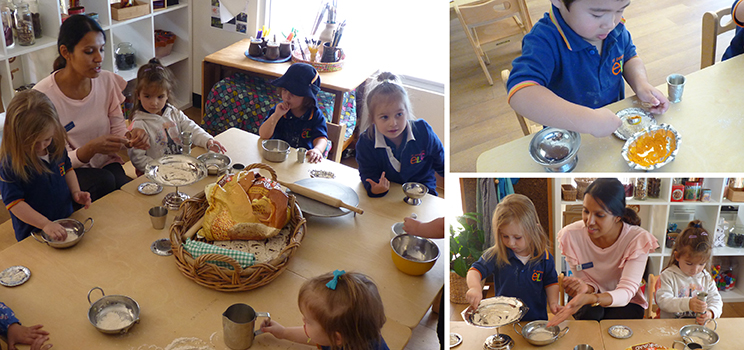
Rituals enable us to slow down and rest our minds and bodies. Every day after lunch the children have the opportunity to sleep or to engage in a rest time ritual that encourages relaxation of body and mind. We have chosen natural elements to focus on such as water, stones, wood, leaves and fabrics.
In the past two weeks we have had a focus on flour, or ‘atta’ as it is called in the Indian language of Ms Sonia Samuels. The ‘atta’ is used to make roti, a traditional Indian bread. Children love to cook, but during rest time we have asked them to simply observe, touch and smell the flour, to really get to know it before combining it with other ingredients. Gradually we have introduced a second element – a spice such as cumin or turmeric, and this has been a delight for our sense of smell and given us something new to contemplate. It also encourages us all to learn about and value the cultural practices of others.
Forming a circle and taking turns to do this also develop social skills as it requires the children think about the rights of others. Learning within a group has enabled the children to co-construct knowledge as they engage with the flour and share their responses to it:
“My Mummy uses flour to make play dough and cookies” – Angelique
“I cook at home” – Patrick
“I have it in my home” – Isla
“My Mummy uses flour for pancakes” – Harriet
As well as being a thoughtful process there has been so much joy. Repeating it each day for two weeks has given the children the opportunity for deep learning as they revisit the experience and deepen their understanding. We are very thankful to Ms Samuels for sharing her culture, language and the special flour with us so generously. Through the ritual of the special flour we have rested but we have also learned so much.
Mel Angel
News from the Bell Yett Room
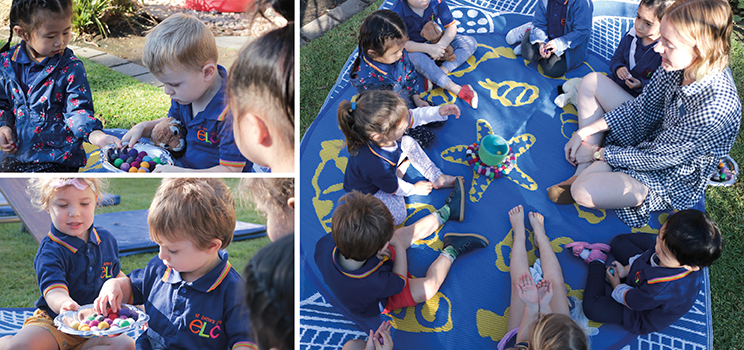
The morning meeting – a ritual to start our day
“Rituals sustain (and grow from) a community’s well-being, its integrity and its alignment with the values at its heart.” – Ann Pelo
In the Bell Yett Room and across Learning Community 1 we strongly value being present in our space and with our company. We look for opportunities to ground ourselves in a moment, focusing on connecting with one another, our role within a group and the community we are building together.
Over the first seven weeks of term, the children and educators in the Bell Yett Room have created a morning meeting ritual together. It grew from humble beginnings of simple greetings, to a meaningful interaction, rich in awareness for one another.
Our morning meeting begins by passing around a dish of ‘eggs’ from the birds in Ferguson Park. We select an ‘egg’ one at a time and hold on to it until everyone in our small circle has one. We then say our ‘Niina Marni’ or acknowledgement to Kaurna land, and then one by one we return our birds ‘eggs’ to the nest, greeting one another as we do so.
This simple ritual has become incredibly meaningful for us. Our children understand:
- Patience and self-awareness
- Sharing and turn taking
- Their role and presence within a group
We acknowledge and greet the individual, but understand that all together we are forming a group. We have learnt that we must collaborate for our ritual to flow, working together to ensure we are giving it our full attention. Displays of agency are evident – after only seven weeks our children are able to conduct the morning meeting ritual without being led by an educator, making sure to include everyone and reminding each other to wait when necessary. The respect they have for one another is evident in their quiet waiting, their eye contact and their greetings.
“We’ve missed William. We can’t leave him behind” – Anna
As educators, we value creating an abundant sense of time for our children. We go into our day calm and attuned, and aware of one another.
Annabelle Redmond
Learning Community 2
News from the Ferguson Room
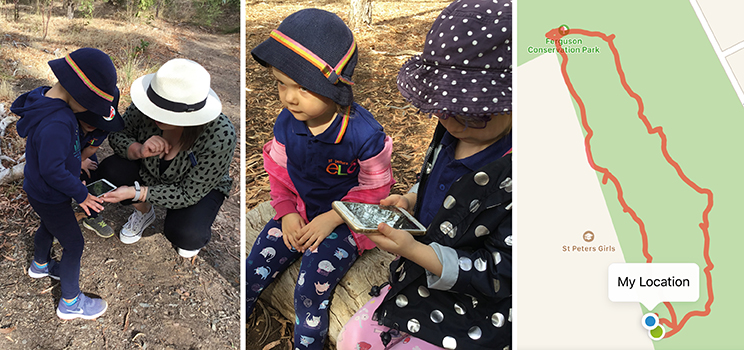
Mapping our world – digital technologies enriching our understandings
Discovering and exploring our school community has become a focus for our inquiry work over the term. We have been looking closely at spaces and places in the ELC and have now extended our focus to the wider school grounds and Ferguson Park.
When we questioned the children about using these spaces the educators shared a challenge;
“How will we know where to go?”
Many children shared their ideas and we discussed places that we already know in the school such as the library, school nurse and the tuck shop.
They also declared that we would need a map! Of course, what a great idea!
In order to document our journeys we looked towards the digital world to enrich our perspectives. The children have been introduce to the application ‘Map my Walk’. This application is able to map in real time where we are walking. Our first experience using this app was in Ferguson Park. We took some time to find out about how the application was going to work. Our beginning point is represented by a green circle and when we began to move a red line appeared lead by a blue circle. As we walked further into the park our red line grew. By the end of our walk we were able to see exactly where we had been.
Using this application, we have been exploring the grounds of the school and have discovered several new locations we can use such as the senior library and the deck overlooking Ferguson Park. We then shared our findings with Mrs Sandercock and her Year 1 class.
The children have been excited about the integration of technology into their learning and we will continue to share our discoveries and findings with you.
Laura Reiters
News from the Hallett Room
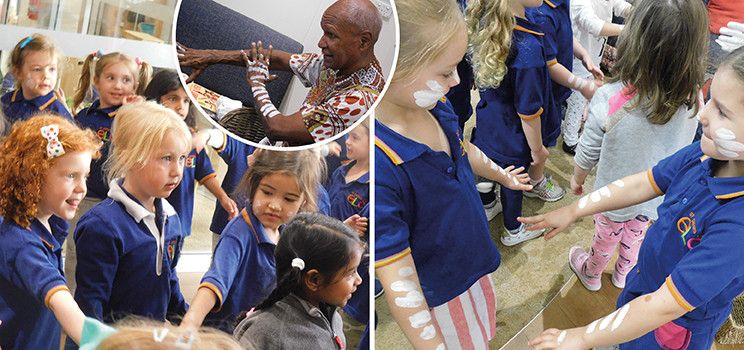
On the path to reconciliation…
“We need to all become storykeepers if we are to belong here in this country.” – Boori Monty Pryor
Several years ago the ELC began a journey with two distinct but intertwined intentions. As early childhood educators, we knew it was our responsibility to share our rich Aboriginal culture and history with our children. We were also discovering the numerous benefits of children learning in nature, not only for their wellbeing but the wellbeing of our planet.
We made a commitment to embed Aboriginal culture and history in our daily life in the ELC. This went hand in hand with developing our ecological identity through regular visits to Ferguson Park. We began by inviting Boori Monty Pryor to visit us. I was lucky to have worked with Boori several years ago and knew of his passion and talent in sharing his culture with young children. Based in Melbourne, Boori spends much of the year travelling Australia and visiting schools, opening people’s hearts and minds to their own country and their own stories. Boori ignited a spark in all of us, educators and children, and gave us the knowledge and permission we needed to begin on our journey towards Reconciliation.
Last Tuesday the ELC community was delighted to welcome Boori back for the fourth consecutive year. During his visit, Boori gifted us with several of his stories. These stories, some over 30,000 years old, have strong ecological and sustainable messages, equally as important today as when they were created. As he engaged the children with culture through storytelling, song, dance and music, he explained that his stories were now our stories and that together we could create a positive vision for the future for all Australians.
During this time we have been fortunate to have developed a relationship with Tamaru, a Kaurna Elder, who supports us on a regular basis. Ferguson Park is now one of our learning environments which enhances our inquiries, ecological identity, physical and emotional wellbeing, literacy and numeracy understandings and embeds Aboriginal culture and rituals in our daily lives. Through our work with Boori, Tamaru and Ferguson Park, the ELC is proud to have been nominated for a Narragunnawali Award. The Award recognizes exceptional commitment to reconciliation in education across the country. We look forward to sharing more about this process with you.
“The importance of stories, dance, song, movement and painting lives within all cultures. Poetry through rhythm breathes life into the soul. When everybody dances and tells their stories together, they ignite the fire to inspire understanding. Within this circle of dance, song and painting is a nutritious cultural feast that feeds the soul, ignites the mind and helps us to not only talk in the same circle but also write on the same page.” – Boori Monty Prior
Nell Tierney and Leanne Williams

